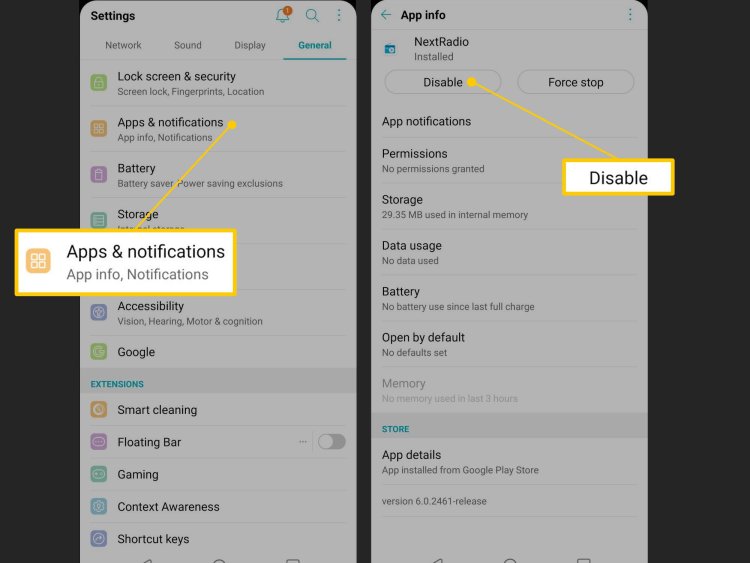How to uninstall Android apps
Take five minutes of free time and find out how to uninstall Android apps thanks to the instructions below. We will first see how to delete applications in a "standard"

Enthusiastic about the purchase of your first Android smartphone , you have stocked up on apps: you have downloaded everything you could find in the Play Store and now, as largely predictable, you no longer have the space to do anything. Given the situation, there is no doubt: your mobile phone needs a massive "cleaning" work. You have to make a selection of the apps you really need and you have to get rid of all the others. You already know how to proceed, right? No?! So let's fix it now, there is no more time to waste.
Take five minutes of free time and find out how to uninstall Android apps thanks to the instructions below. We will first see how to delete applications in a "standard" way by acting from the Android settings, then we will find out how to remove multiple apps in sequence and how to delete all those applications that cannot be uninstalled as they are protected at the system level.
You ask me if you can also remove those apps, often useless, that are pre-installed on many Android smartphones? The answer is yes, we will take care of that too. For now let's focus on the most basic operations and see how to uninstall "normal" apps from all popular versions of Android, I assure you it's really a breeze!
How to uninstall Android apps: standard procedure

Let's start this guide by analyzing the steps to be taken to uninstall Android apps according to the standard procedure provided by the operating system, which allows you to delete applications that are no longer useful in no time.
I anticipate that the names of the buttons and menu items that you will find in this chapter may be slightly different from what you see on the screen, mainly due to the small differences between one version of Android and another.
In any case, the simplest method of acting is to locate the app icon on the Home screen or in the drawer of the device, make a long tap on it and drag it to the Uninstall / Delete button or the trash can icon , which should appear on the screen. In some cases, the aforementioned items appear in a “dedicated” menu. To permanently delete the app, reply affirmatively to the next warning by tapping the Uninstall / OK button .
Alternatively, you can get the same result by acting from the Android Settings : open the latter by tapping the gear symbol resident on the Home screen or in the device drawer, reach the Apps and notifications> Show all apps sections and tap on the name of the application you want to delete. Finally, tap the Uninstall and OK buttons and that's it.
On some devices the path to follow is slightly different: if, for example, yours is a Xiaomi smartphone with the MIUI operating system on board , you must go to Settings> Apps> Manage apps and, after tapping on the name of the application to uninstall, tap the Uninstall and OK buttons .
Among other things, the most recent versions of Xiaomi's MIUI also allow you to delete multiple apps at the same time: to do this, enter the Settings> Apps> Manage apps panel , touch the trash can icon (the Uninstall button ) located at the top and put the check mark next to each of the applications you want to get rid of. Finally, tap the Uninstall [XX] MB button and finish everything by pressing the OK button .
How to uninstall pre-installed Android apps
Have you purchased a "branded" smartphone from a specific manufacturer, or have you noticed the presence of system applications, useless for you, that cannot be eliminated with the standard procedure I mentioned earlier?
In that case, you will be pleased to know that there are numerous applications that allow you to uninstall pre-installed Android apps in no time. However, it is good to specify two fundamental things: the first is that the device must have previously been subjected to the root procedure , otherwise the procedure will not be successful; secondly, deleting a pre-installed and / or system app can make your smartphone unstable or unusable, forcing you to reset it.
Personally, I will not be held responsible for any malfunctions or damages that you may encounter, following the implementation of the instructions I am about to give you: I have warned you!
Having made this necessary premise, let me explain how to act. Among the many apps available, I suggest you give System App Remover an opportunity : available for free on the Play Store and on alternative stores for devices that do not have Google services (with the presence of advertisements), it allows you to delete applications installed on Android with ease.
Furthermore, if something should go wrong, it is possible to restore the deleted app on the fly, thanks to the practical basket available; System app Remover is also available in the paid Pro version , at a cost of € 1.89, without advertisements.
To get it, connect to the reference store of your device, search for the app using the appropriate field and, when you have found it, tap the Install button to download it to your device.
Once this is done, start the app and allow the root access request , by tapping the appropriate button. If all went well, you should now see the list of system applications included in the device: being careful not to uninstall those marked with [To keep] or [Key Module] , which are essential for running Android, put the sign of tick next to the name of the app (or apps) to be removed, tap the Uninstall [X] MB button and confirm your willingness to proceed by tapping the Yes button .
Once uninstalled, all you have to do is restart the device and check that the unwanted app is no longer there, in its place. In case of problems, you can restore uninstalled apps with ease: start System App Remover , tap on the trash can symbol visible at the top, put the check mark next to the name of the application to restore and tap the Restore and Yes buttons , to to conclude.
If your phone doesn't have root permissions (or if you think this solution is too risky), you can take a softer approach, deleting all system application updates and disabling the ones you don't need. Find everything explained in the next chapter of this guide.
How to uninstall Android app update
Did you notice that one of the Android apps started acting weird after receiving an update? In this case, the simplest way is to delete it from the operating system, and then reinstall it after the release of any corrective updates.
However, if it is an application that comes pre-installed with your smartphone and, consequently, cannot be deleted (unless you have root permissions), you can uninstall its updates and then disable it , waiting for things to return to normal.
Doing so is very simple: first, open the Android Settings , by tapping on the symbol of the resident gear on the Home screen or in the drawer of the device, tap the items Apps and notifications and Show all the apps and then tap on the name of the app for which you intend to delete updates. Finally, tap the Uninstall updates and OK buttons .
Finally, to avoid future problems due to the involuntary reinstallation of updates, I recommend that you completely disable the app: following this operation, it will disappear from the list of apps in the drawer and / or on the Home screen, it will not receive future updates. unless it is manually re-enabled.
To deactivate an application, go back to the Settings menu> Apps and notifications> Show all apps> [app name] of Android, tap the Deactivate button and answer affirmatively to the next warning, to conclude. To activate it again, repeat the same steps and press the Activate button this time .
If, for some reason, you have not been able to delete "unwanted" Android apps directly via your smartphone, you can cope with this by using ApowerSoft ApowerManager , a program for Windows and macOS, equipped with numerous functions, including the one to uninstall apps . Basically, ApowerManager is free software, but a paid version is available that unlocks additional features (not useful for the purposes of this guide).
In any case, to download the program, connect to this website and click on the Download now button , to start downloading the program installation package.
Later, if you use Windows , open the .exe file you just downloaded and click on the Install now button , to start the program setup, which will be terminated automatically (remember to consent to the UAC request). At the end of the installation of the program, click on the Open now button and then on the Yes button , twice consecutively, in order to initialize the necessary components.
If, on the other hand, yours is a Mac , open the .pkg file you downloaded earlier and click on the Open button , in order to bypass the restrictions imposed by Apple on files of this type. Then, click on the Continue button twice consecutively, then on Accept and Install ; when prompted, enter your Mac password in the appropriate field, click the Install software button and wait for the installation to complete. The software should start automatically.
From now on, the procedures for Windows and macOS are the same: at the first start, you should see the registration request window: to avoid it, click on the (X) located at the top right.
At this point, connect the smartphone to the computer via USB cable and activate USB debugging , in order to authorize the communication of the software with the computer: to do this, go to the Settings menu> About Android phone / device and tap on the item Build number seven consecutive times to unlock development options .
Once this is done, go to the Settings> System menu , tap the Advanced and Developer options / Development options items and move the lever for the Android / USB Debugging item to ON . Finally, reply affirmatively to the message that is proposed to you ( more info here ).
After a few moments, a notification regarding USB debugging permissions should appear on the screen of the Android device : put the check mark next to the wording Always allow from this computer and tap the Allow button , to definitively authorize the communication.
At this point, go back to the computer and click on the Allowed button, next , visible in the ApowerManager window, and wait a few moments for the device to be correctly recognized and configured.
Now, click on the Applications button located at the top of the program screen, select the Installed item visible in the left sidebar and wait for the access requests to the various memory elements to appear on the Android device screen. When this happens, tap the Allow button several times to grant the necessary permissions.
At this point, in the ApowerManager window, the list of apps installed on the device should appear; to delete them, put the check mark next to their names and click on the Uninstall button , located at the top, to proceed. If necessary, click on the Yes button and that's it.

















